This study assessed the impact of sucrose and trehalose as osmotic agents on the quality of freeze-dried starfruit snacks, with particular emphasis on sensory and textural attributes. Starfruit slices were subjected to three pre-treatments before freeze-drying: a control (no dehydration agent), osmotic dehydration in a sucrose solution (ODSAC), and osmotic dehydration in a trehalose solution (ODTRE). The resulting dehydrated samples were analyzed for water activity (aw), instrumental color and texture, and sensory attributes, including consumer acceptability. Both osmotic treatments significantly altered the instrumental texture of the starfruit slices compared to the control. Sensory analysis revealed significant differences in appearance, texture, flavor, and odor among treatments, with the ODTRE treatment receiving the highest acceptability scores. These findings suggest that using trehalose as an osmotic agent enhances the quality attributes of the dehydrated starfruit slices, supporting their potential as a fruit snack option.
Keywords: carambola, pre-treatment sugars, acceptability, instrumental hardness, flash profile.
Este estudo avaliou o impacto da sacarose e da trealose como agentes osmóticos na qualidade de um snack de carambola liofilizada, com foco especial em atributos sensoriais e texturais. As fatias de carambola foram submetidas a três pré-tratamentos antes da liofilização: controle (sem agente de desidratação), desidratação osmótica em solução de sacarose (ODSAC) e desidratação osmótica em solução de trealose (ODTRE). As amostras desidratadas finais foram analisadas quanto à atividade de água (aw), cor instrumental, textura instrumental e análise sensorial, incluindo a aceitabilidade pelos consumidores. Ambos tratamentos osmóticos alteraram a textura instrumental das fatias de carambola em comparação com o controle. A análise sensorial revelou diferenças significativas na aparência, textura, sabor e odor entre as amostras, sendo o tratamento com trealose (ODTRE) o que recebeu as maiores pontuações de aceitabilidade. De modo geral, o uso da trealose como agente osmótico melhorou os atributos de qualidade das fatias de carambola desidratadas, destacando seu potencial como opção de lanche de fruta.
Palavras-chave: carambola, pré-tratamento com açúcares, aceitabilidade, dureza instrumental, perfil flash.
Introduction
Fruit is an essential component of a healthy and balanced diet, providing vitamins, minerals, and antioxidants that promote optimal health and reduce the risk of disease. The World Health Organization recommends consuming two to three servings of fruit per day as part of a healthy diet (Nishida et al., 2004). However, fruit consumption varies significantly by country and region. For example, in Argentina, according to the 2018 National Survey of Risk Factors (ENFR), only 6% of the population met the recommended requirements, suggesting that new strategies are needed to increase the consumption of fruits and vegetables (Argentina. Ministerio de Salud y Desarrollo Social, 2018).
Starfruit (Averrhoa carambola L.) is a tropical fruit with a characteristic star-shaped cross-section and a sour-to-sweet taste. It is a rich source of antioxidants, vitamin C, potassium, phosphorus, magnesium and dietary fiber, and is low in carbohydrates and calories (Shofian et al., 2011; Sharma and Shantaram, 2013; Ramadan et al., 2020). Due to its unique shape and taste, starfruit has gained popularity both as a fresh fruit and as the main ingredient in processed products such as jams, juices (Mamede and Benassi, 2016), and candies.
Dehydrated fruits, in particular, offer a means of developing healthy and convenient snack products (De Vlieger et al., 2017; Schlinkert et al., 2020; Sadler et al., 2019). Dehydration preserves fruit by reducing its water content, thereby inhibiting microbial growth, extending shelf life, and offering a convenient option for storage and consumption (Prosapio and Norton, 2017). Osmotic dehydration (OD), for example, is a technique used to lower the water activity (aw) of foods—primarily fruits—by immersing them in a concentrated sugar solution (Ciurzyńska et al., 2016). OD is commonly employed as a pre-treatment to improve the quality of fruits that will undergo more energy-intensive drying methods such as air-drying or freeze-drying (Alvarez et al., 1995; Nieto et al., 1998; Iglesias et al., 2017; Sette et al., 2016).
Sucrose is commonly used in OD of fruits because of its sensory acceptability and wide availability. However, sucrose solutions can cause quality defects such as non-enzymatic browning and sucrose crystallization owing to its relatively low glass transition temperature (Tg), which compromises structural stability. Alternative sugars, like trehalose, have been proposed to overcome these disadvantages (Iglesias et al., 2017).
Trehalose is a non-reducing disaccharide known for its cryoprotective, thermoprotective, and stabilizing effects on biological systems (Roser, 1991). With a sweetness level of only 45% that of sucrose (Birch et al., 1970; Galmarini et al., 2009), trehalose is particularly well-suited for fruit preservation without significantly increasing perceived sweetness (Galmarini et al., 2009). It has been employed as an osmotic agent in the dehydration of various fruits and vegetables, such as bananas, carrots, potatoes, and mangoes (Aktas et al., 2007; Iglesias et al., 2017; Tan et al., 2020). However, limited information exists regarding its use in the osmotic dehydration of starfruit slices.
As proposed by Castagnini et al. (2022), trehalose may enhance the crispness of dehydrated fruits by promoting greater water removal during drying, which leads to a more compact structure due to shrinkage. Furthermore, the collapse of cells and pores, along with alterations in the carbohydrate matrix, contribute to the improved crispness of the final product.
Sensory and instrumental analyses are useful tools to evaluate the effects of osmotic agents on texture and flavor. Flash Profile, a rapid descriptive method (Dairou and Sieffermann, 2002), allows panelists to freely generate their own vocabulary. This method has been successfully applied to characterize dehydrated fruits and vegetables, quickly offering valuable insights into consumer-relevant attributes (Tarea et al., 2007; Dueik et al., 2013; Bredie et al., 2017; Pérez-González et al., 2023) while avoiding lengthy training sessions.
The aim of this study was to determine the sensory and physicochemical characteristics of freeze-dried starfruit snacks subjected to osmotic pre-treatments using sucrose or trehalose.
Materials and Methods
Sample preparation
Fresh starfruits were purchased from a local grocery store in Buenos Aires, Argentina. The fruits were sanitized in a 0.15% sodium hypochlorite solution for 15 minutes, then sliced crosswise into star-shaped pieces approximately 5 mm thick. Seeds were manually removed, and the slices were immersed for 20 minutes in an anti-browning acidic solution containing 0.5% citric acid and 0.5% ascorbic acid (both supplied by Biopack, Argentina).
After acidification, the slices were divided into three treatment groups:
- Control: slices were frozen at –40 ℃ and then freeze-dried in a laboratory freeze-dryer (RIFICOR L-A-B4-C, Argentina) for 48 hours (freezing plate at –35 ℃, vacuum < 100 μmHg).
- ODSAC (osmotic dehydration in sucrose): slices were immersed in a 40% w/w sucrose solution (food-grade; purchased locally) for 2 hours at 25 ℃, then frozen at –40 ℃ and freeze-dried following the same procedure as the control.
- ODTRE (osmotic dehydration in trehalose): slices were immersed in a 40% w/w trehalose dihydrate solution (Treha™) for 2 hours at 25 ℃, then frozen at –40 ℃ and freeze-dried following the same procedure as the control.
All dehydrated fruit pieces were packed in polyamide–polyethylene pouches, heat-sealed, and stored at –18 ℃ until analysis.
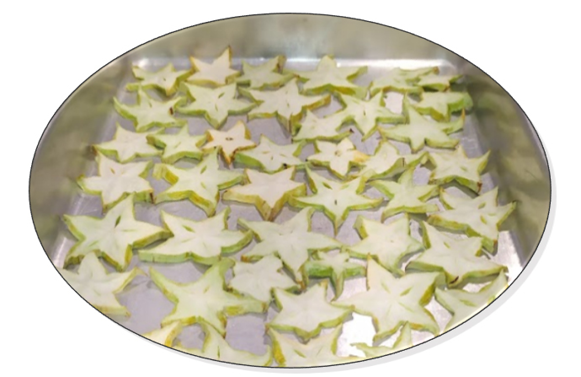
Figure 1. Example of starfruit snack (after dehydration).
In this study, a moderate sugar concentration (40% solutions) was intentionally selected for two main reasons. First, health-conscious consumers are increasingly cautious about products with high added sugar content. Second, trehalose has a lower water solubility than sucrose (68.9 g/100 g H2O at 20 ℃) (Galmarini et al., 2008), which limits the maximum practicable concentration for the trehalose solution.
Water activity
Water activity (aw) of the starfruit snacks was measured at 23–24 ℃ using a dew-point hygrometer (Aqualab Series 3B, Decagon Devices, Pullman, WA, USA). The instrument was calibrated and verified using standard unsaturated NaCl solutions covering the aw range of interest (Chirife and Resnik, 1984). For each treatment batch, aw measurements were performed in triplicate, and results were reported as the mean ± standard deviation.
Instrumental color
Color of the dehydrated starfruit snacks was measured with a chroma meter (Minolta CR-400, Konica Minolta, Japan) using the CIE Lab* color scale (L* = lightness; a* = redness/greenness; b* = yellowness/blueness). The instrument was set to D65 illuminant and a 2° observer angle and calibrated against a white standard tile. Each sample’s color was measured six times at different locations.
Instrumental texture
The instrumental texture of the dried starfruit slices was measured using a Texture Analyzer (TA.XT.Plus, Stable Micro Systems, 2018) equipped with a 5-kg load cell. Each dried slice was punctured at the center with a rounded-end spherical probe (P/0.5 S) using a Crisp Fracture Support Rig. Test parameters were as follows: pre-test speed of 1.0 mm/s, test speed of 0.7 mm/s, post-test speed of 10.0 mm/s, trigger force of 0.049 N, and puncture distance of 11 mm.
Data were processed using Texture Expert EXCEED software (Stable Micro Systems, 2018). Ten replicate measurements were recorded for each treatment.
Descriptive sensory evaluation
Descriptive sensory evaluation using the Flash Profile method was carried out by 14 trained panelists (all female, aged 27–52) from the staff of the Instituto de Tecnología de Alimentos (Buenos Aires). Panelists were preselected based on regular fruit consumption, availability, and prior experience in sensory analysis. All participants provided informed consent. Evaluation sessions were conducted in individual sensory booths under standardized white lighting (6,000 K).
Flash Profile evaluation of the three snack treatments was conducted over three sessions, each lasting approximately 40 minutes. During the first two sessions, panelists received all three samples and individually generated descriptive terms they considered most relevant for distinguishing between the products. Each panelist was instructed to generate at least eight descriptors covering appearance, texture, flavor (aroma and taste), and odor.
In the third session, all three treatments were presented simultaneously, and panelists ranked the samples for each descriptor, one descriptor at a time, based on perceived intensity. Panelists were allowed to re-taste the samples and take as much time as needed for each ranking (Bredie et al., 2017). A continuous linear scale was used to allow assessors to indicate the relative distance between samples in terms of intensity differences for each attribute.
On average, panelists generated approximately 10 descriptors each. Following a consolidation step involving lemmatization by the panel leader and assistant, a final set of descriptors was agreed upon and grouped into four sensory categories: appearance (4 descriptors), texture (6), flavor/taste (7), and odor (1).
Samples were served on plastic plates labeled with random three-digit codes, following a balanced block design. Presentation order was randomized across panelists and sessions. Water was provided for palate cleansing between samples.
Hedonic assessment
A consumer acceptability test was conducted at the Sensory Analysis Laboratory of Universidad Católica Argentina (Buenos Aires) in individual booths under white lighting. Seventy-five untrained consumers (25 male, 50 female, aged 17–58) were recruited via email. All reported consuming fruits or snacks at least four times per week. Informed consent was obtained, and participants recorded their responses anonymously using their smartphones.
Each consumer evaluated the three treatments monadically in a single session. Samples were served on plastic plates labeled with random three-digit codes, and presentation order was randomized across consumers. Water was provided for palate cleansing.
Consumers tasted each sample and rated overall liking using a 9-point hedonic scale (1 = Extremely Dislike, 9 = Extremely Like; 5 = Neither like nor dislike). After tasting, they completed a short survey in which they were shown a photo of a whole starfruit and asked whether they recognized it or had tried it before. They were also asked whether they liked the shape of the dehydrated snack and whether its appearance made it more appealing.
Statistical analysis
Physicochemical measurements
For each aw determination, three replicates per batch were analyzed, and results were expressed as mean ± standard deviation. Color measurements were performed in six replicates, and results were expressed as mean L*, a*, and b* values. For both determinations, statistical differences among samples were assessed using one-way analysis of variance (ANOVA), followed by Student–Newman–Keuls (SNK) post-hoc tests (p < 0.05). All analyses were performed using InfoStat software (Di Rienzo et al., 2017).
For instrumental texture, force–distance data were processed using Texture Expert EXCED software to obtain values for hardness, brittleness, crispness, and crunchiness. Each texture parameter was analyzed by one-way ANOVA, followed by SNK post-hoc tests (p < 0.05) using InfoStat (Di Rienzo et al., 2017). Global differences among samples were visualized using principal component analysis (PCA). Additionally, multivariate analysis of variance (MANOVA) and Hotelling’s T² test with Bonferroni correction were applied to confirm overall differences between samples.
Sensory measurements
Flash Profile data were analyzed by General Procrustes Analysis (GPA) (Gower, 1975) using XLSTAT (Addinsoft, 2023).
Hedonic liking scores were subjected to one-way ANOVA to compare the three treatments, followed by Tukey’s HSD post-hoc test (p < 0.05), using InfoStat (Di Rienzo et al., 2017). Consumers were further segmented by hierarchical cluster analysis, and internal preference mapping (PrefMap) was applied to the resulting clusters using FIZZ software (Biosystèmes, 2022).
The relationship between sensory attributes and instrumental texture parameters was explored using principal component analysis (PCA) in XLSTAT (Addinsoft, 2023).
Results
Soluble solids content and aw
Table 1 presents the total soluble solids (ºBrix) before and after osmotic dehydration (OD), as well as the final aw after freeze-drying for the three treatments. Given the naturally low sugar content of starfruit, osmotic dehydration resulted in an almost tenfold increase in soluble solids.
Table 1. Total soluble solids (°Brix) before and after osmotic dehydration (OD), and final water activity after freeze-drying, for the three treatments.

Values are expressed as mean ± standard deviation. Different uppercase letters within the same row indicate significant differences among treatments (SNK test, p < 0.05).
Although final aw differences were not statistically significant (Table 1), the ODSAC sample showed a slightly higher aw compared to the other treatments despite its greater sugar uptake.
Color
Figure 2 shows the mean L*, a*, and b* color values for the three treatments. A significant difference was observed only in L*, with control samples exhibiting higher L* values (lighter color) than ODTRE, while ODSAC presented intermediate values. No significant differences were found in a* or b* values among the treatments.
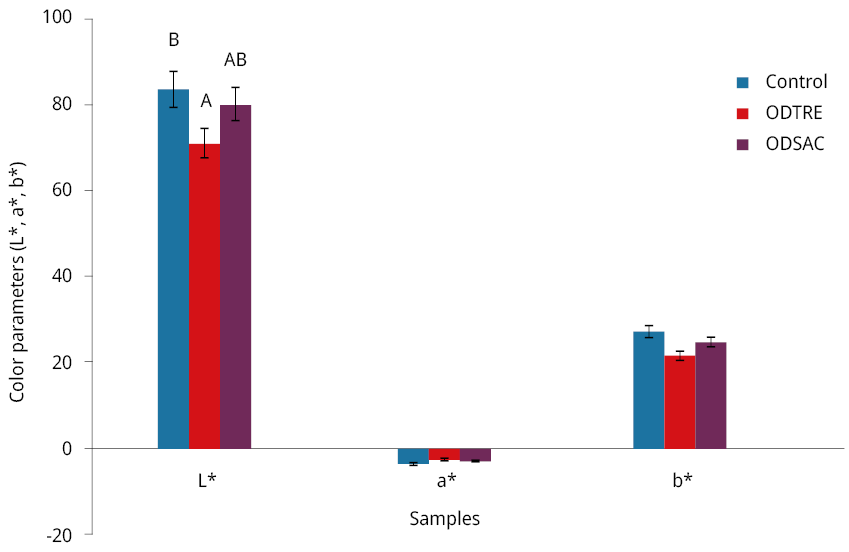
Figure 2. Color parameters L* (lightness), a* (greenness) and b* (yellowness) for the three treatments. Different uppercase letters indicate significant differences among treatments (SNK test, p < 0.05).
Instrumental texture
Table 2 presents the mean values ± standard deviation for hardness, brittleness, crispness, and crunchiness for each treatment. Osmotic dehydration (OD) pre-treatments using different sugars had distinct effects on the final texture of the snacks.
Table 2. Instrumental texture parameters for the three treatments.

Values are expressed as mean ± standard deviation. Different uppercase letters in the same row indicate significant differences among treatments (SNK test, p < 0.05).
Principal component analysis (PCA; Figure 3) was conducted to evaluate overall texture differences among samples. The results showed that ODSAC was associated with higher hardness and crunchiness, ODTRE was characterized by increased crispness and lower brittleness, while the control exhibited the lowest hardness.
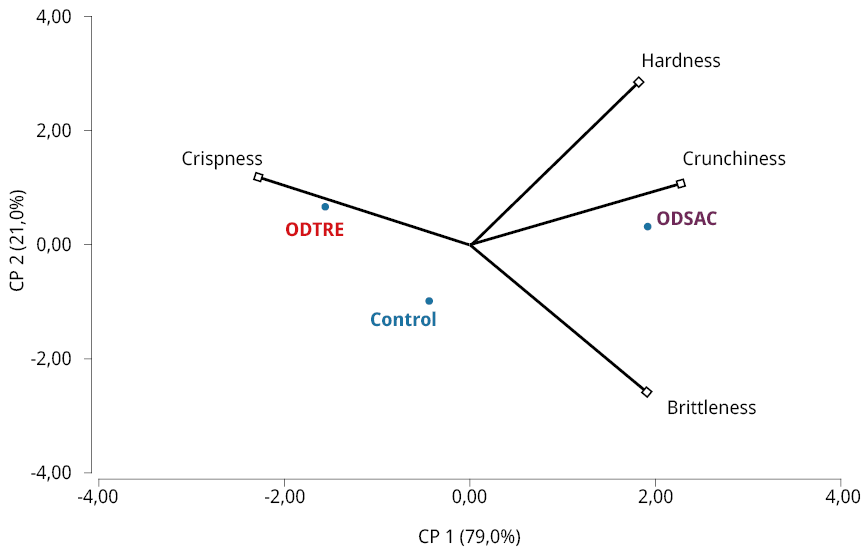
Figure 3. Principal Component Analysis (PCA) of instrumental texture parameters for the three treatments.
Both ODTRE and ODSAC slices were impregnated with disaccharides, which increased the total solids content and resulted in a stiffer dried matrix, requiring greater force to fracture (Dziki, 2020).
Suyatma et al. (2015) reported that in banana chips, “crispy” products are mechanically less resistant than “crunchy” ones, requiring more force to break. This aligns with our findings: ODSAC (sucrose OD) produced slices that were harder and crunchier, whereas ODTRE (trehalose OD) yielded slices that were crisper and less hard.
Sensory descriptive evaluation
Descriptive sensory profile
Flash Profile analysis showed that the three samples had distinct sensory profiles. Panelists generated a broad range of descriptors, which were then grouped into four sensory categories: appearance, texture, aroma, and taste.
Appearance-related descriptors included brightness, color (ranging from yellow-green to brownish), surface moisture (perceived humidity), and shape integrity (the degree to which the characteristic star shape was preserved). Texture descriptors included crispness, crunchiness, gumminess, hardness, porosity, and stickiness. The only odor descriptor identified (orthonasal) was a green fruity odor. Flavor and taste descriptors included aftertaste, astringency, bitterness, fruity flavor, green (unripe) flavor, sourness, and sweetness.
General Procrustes Analysis (GPA) of the Flash Profile data (Figure 4) showed clear sensory discrimination among the three treatments. The control sample was described by attributes such as gumminess, porosity, and sourness. ODSAC was characterized by astringency, hardness, stickiness, and sweetness. ODTRE was associated with higher aftertaste, crispness, crunchiness, and fruity flavor.
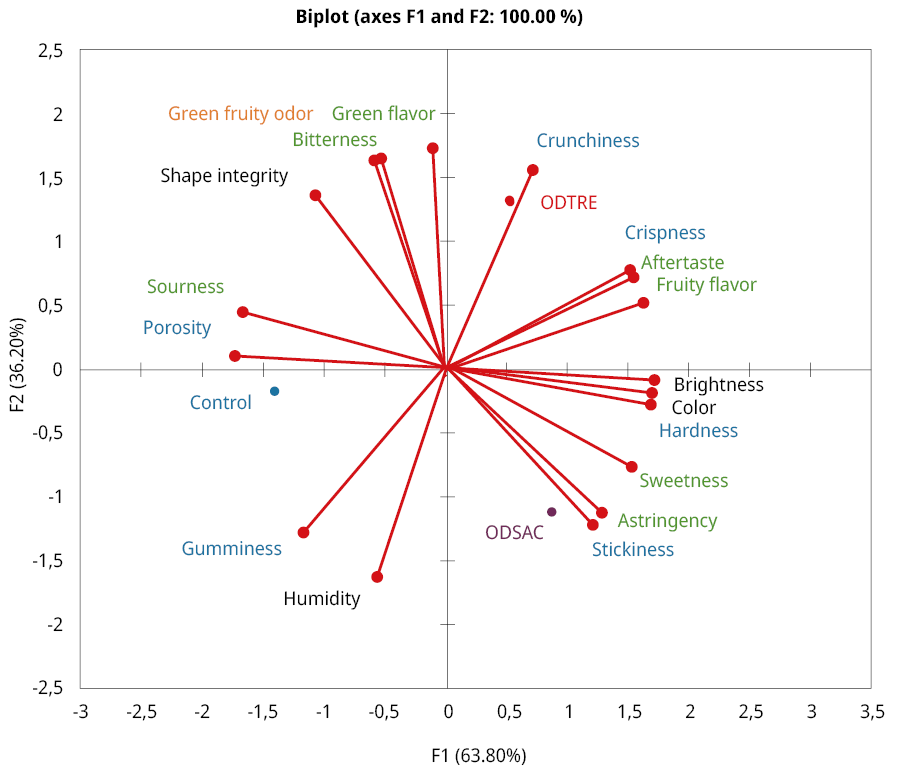
Figure 4. General Procrustes Analysis (GPA) of the Flash Profile intensity scores for the three treatments.
Consumer acceptability
The mean overall liking score for ODTRE was significantly higher than those for the control or ODSAC (Table 3).
Table 3. Liking scores of the samples.

Values are expressed as mean ± standard deviation. Different uppercase letters indicate significant differences among treatments (Tukey test, p < 0.05).
Crispness is widely recognized as a desirable attribute in dried snacks (Kayacier and Singh, 2003; Wong et al., 2020; Pravitha et al., 2021). However, consumer preferences may also be influenced by other sensory characteristics. To better understand the drivers of liking, a hierarchical cluster analysis was conducted based on preference scores. Although the consumer sample size was limited, the analysis provided valuable insights for potential product optimization. Three distinct consumer clusters were identified (Table 4).
Table 4. Overall liking scores of each sample by consumer cluster.

Cluster 1 (35% of consumers) showed a higher preference for the ODTRE and control samples. Cluster 3 (48%) preferred the ODTRE and ODSAC samples, while Cluster 2 (17%) gave relatively low liking scores to all three samples, but still showed a slight preference for ODTRE and control. Notably, ODTRE was among the most liked treatments across all clusters.
The preference patterns of Clusters 1 and 2 seem to be influenced by sensory attributes such as shape integrity, green fruity odor and flavor, and bitterness. In contrast, Cluster 3 consumers showed a positive association with attributes like hardness, color, and brightness (Figure 5).
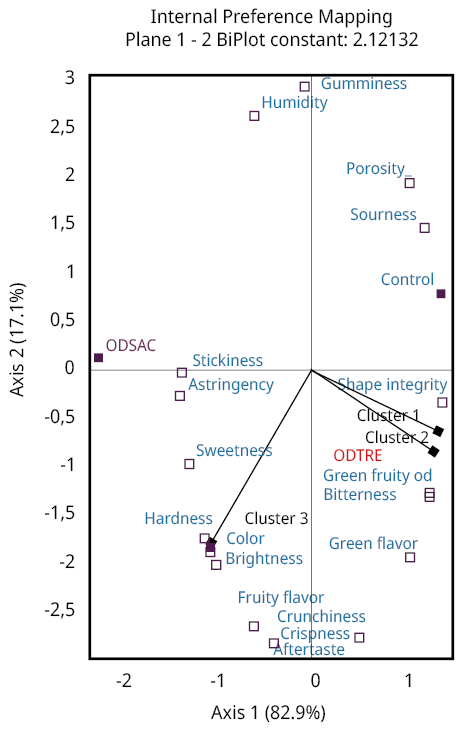
Figure 5. Internal preference map showing the relationship between consumer clusters and Flash Profile attributes for the three samples.
Correlation between instrumental and sensory texture
A combined PCA of instrumental and sensory texture data was performed to explore their relationships (Figure 6). A clear correlation was observed between instrumental and sensory hardness. However, no direct one-to-one correspondence emerged for crispness and in particular for crunchiness. Notably, the sensory attribute crunchiness was more closely aligned with the instrumental measurement of crispness than with instrumental crunchiness. This discrepancy may be attributed to the tendency of Spanish-speaking panelists to use the terms “crispy” and “crunchy” interchangeably, leading to a semantic overlap between these descriptors (Varela et al., 2008). The PCA also indicated that instrumental brittleness was associated with the sensory descriptors porosity and gumminess. Porosity was likely perceived both visually and during the initial bite reflecting a brittle, airy structure, while gumminess became more evident in later stages of chewing as the product formed a cohesive bolus. This interpretation aligns with known texture transitions during oral processing (Chen and Stokes, 2012).
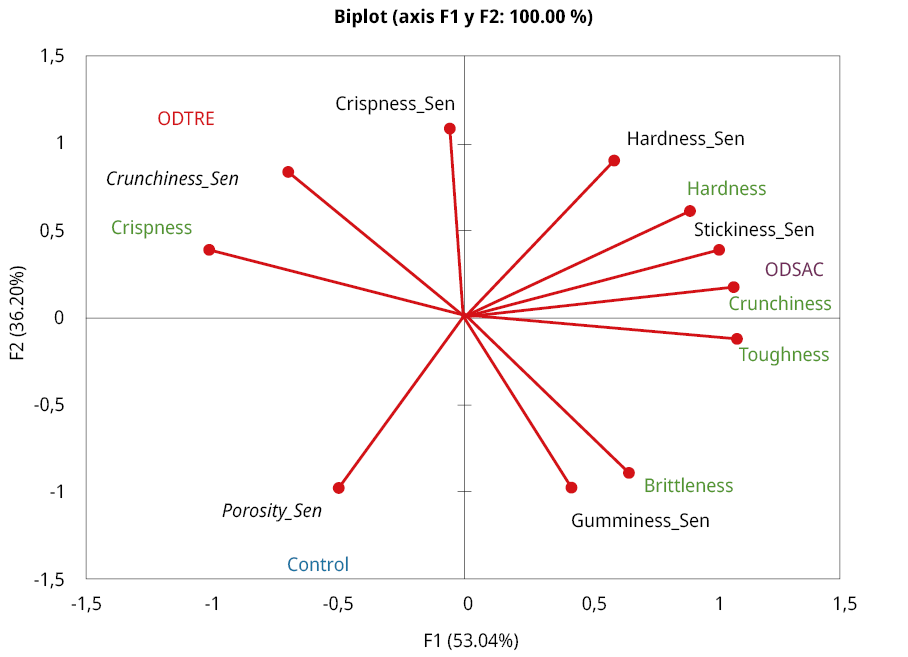
Figure 6. Principal Component Analysis (PCA) of sensory and instrumental textural measurements of the three samples.
Discussion
The results showed that both types of sugar used in osmotic dehydration (OD) significantly influenced the final properties of the starfruit slices. Both OD-treated samples differed markedly from the control (which had no OD pre-treatment), highlighting the role of sugar impregnation in altering product characteristics.
The effects of OD on the physical and sensory properties of fruits and vegetables have been widely studied using a variety of osmotic agents and process conditions (Konopacka et al., 2009; Ahmed et al., 2016). For starfruit specifically, previous studies have employed sucrose as the osmotic agent, but to our knowledge, none have reported the use of trehalose. Castillo and Cornejo (2007), for example, studied OD kinetics in starfruit slices with sucrose solutions of 40, 50, and 60 °Brix, and found an increase in monolayer moisture content, indicating enhanced product stability prior to drying. Similarly, Grajales-Agudelo et al. (2005) reported favorable results using a 65 °Brix sucrose solution before freeze-drying starfruit. Given that starfruit is naturally low in carbohydrates and energy (under 10 g of sugars and ~36 kcal per 100 g of fruit) (Sharma and Shantaram, 2013), OD with added sugars can substantially modify the product’s composition and structure.
Although ODTRE and ODSAC samples differed significantly in total soluble solids content (Table 1), the magnitude of this difference was modest. Nevertheless, marked differences in instrumental texture parameters were observed between the treatments. These distinctions may be attributed to the unique structural effects of trehalose and sucrose on the dried matrix.
Trehalose-treated products are generally more stable than those treated with sucrose (Galmarini et al., 2009), due to trehalose’s higher glass transition temperature (Tg) (106 ℃ vs 60 ℃ for sucrose; Roe and Labuza, 2005). The lower Tg of sucrose is associated with higher hygroscopicity (Roos and Karel, 1991), which may explain the increased stickiness and surface tackiness observed in ODSAC samples under ambient conditions (Figure 4). However, further shelf-life studies are needed to quantify this effect.
The significant increase in total soluble solids following OD in both treatments (Table 1) aligns with previous findings (Iglesias et al., 2017). This sugar uptake contributed to notable changes in texture. ODSAC samples exhibited the highest hardness and crunchiness (Table 2), likely due to the stiffening effect of increased solids content, which raises the force required to fracture (Dziki, 2020). Similar outcomes were reported by Díaz Barrios (2017), who observed increased hardness in freeze-dried banana slices pretreated with sucrose or trehalose. Moreover, Flash Profile data showed that control samples had higher porosity, which may explain their higher L* values (Figure 2) due to enhanced light scattering in a more porous structure (Nowak and Jakubczyk, 2020).
Sensory analysis confirmed significant differences in attributes such as crispness, crunchiness, gumminess, hardness, porosity, and stickiness. The combined PCA (Figure 6) comparing instrumental and sensory texture measurements showed strong alignment between instrumental and sensory hardness suggesting that puncture force measurements reliably reflect perceived hardness. However, no direct one-to-one correspondence was observed for crispness and crunchiness. Panelists’ perception of crunchiness correlated better with instrumental measurement of ‘crispness’ count than with the quantification of ‘crunchiness’ (area under the curve). This may reflect both linguistic and perceptual overlap: in Spanish “crujiente” and “crocante” are often used interchangeably (Varela et al., 2008) and the auditory cues linked to multiple fracture events may be perceived as crispness. PCA also indicated that instrumental brittleness correlated with sensory porosity and gumminess likely reflecting a structural eating sequence. A highly brittle matrix is initially perceived as porous (visually and during biting) and collapses quickly, and as the product breaks down, it forms a cohesive bolus that elicits a sensation of gumminess (Chen and Stokes, 2012).
Flavor perception also differed between treatments. Komes et al. (2003, 2005, 2007) investigated aroma retention in dehydrated fruit products and found that trehalose addition prior to drying enhanced the retention of volatile compounds responsible for fruit aroma. In our study, ODTRE samples were preferred by consumers and described as having a fruity flavor and a green fruity aroma (Figure 5). Galmarini et al. (2009) also found that trehalose helped maintain a balanced sweetness–sourness profile in strawberry puree products. In the case of starfruit snacks, the lower sweetness of trehalose may have preserved more of the fruit’s natural tartness, contributing to a more authentic flavor. This might explain the higher overall liking scores for ODTRE, which was perceived as less sweet than ODSAC and retained more of the fruit’s original flavor. Excessive sweetness may also conflict with the expectation of a healthy fruit-based snack.
In Argentina, starfruit is cultivated only in a small northern region of the country and remains unfamiliar to most consumers. A post-test survey confirmed that 67% of participants had never heard of or tried starfruit before, and only 8% had previously tasted it. Interestingly, 92% of the consumers found the star shape appealing, and 67% indicated that the shape increased their willingness to try the snack. Only 3% disliked the shape, and 5% were neutral. These findings, together with the high hedonic ratings for the Trehalose-treated samples, suggest strong potential for introducing freeze-dried starfruit snacks to new markets. The combination of visual appeal, health perception and distinctive flavor profile —especially in the ODTRE formulation— positions this product as a promising and innovative fruit snack.
Conclusions
The results of this study demonstrate that osmotic dehydration with trehalose is a promising strategy for producing freeze-dried starfruit snacks with improved sensory and textural properties compared to samples treated with sucrose or without osmotic pre-treatment. Trehalose-treated samples exhibited more desirable texture attributes —such as chip-like crispness and lower stickiness— and received the highest consumer acceptability ratings. These samples also retained more of the fruit’s characteristic flavor, aligning well with consumer expectations for a chip-like healthy fruit snack. In contrast, sucrose-treated samples were perceived as stickier and may be less texturally stable over time, likely due to sucrose’s higher hygroscopicity.
This study also highlights the potential of adding value to underutilized seasonal tropical fruits like starfruit by transforming them into convenient and appealing snack formats. The fruit’s distinct natural star shape provides a unique marketing advantage, enhancing visual appeal and increasing consumers’ willingness to try it. Combining this natural appeal with the functional benefits of trehalose as an osmotic agent offers a promising approach for developing innovative, shelf-stable, and consumer-friendly fruit-based snacks.
Acknowledgments
This research was funded by Instituto Nacional de Tecnología Agropecuaria (INTA). The authors wish to express their gratitude to Flair S.R.L. for kindly providing trehalose.
References
Addinsoft, 2023. XLSTAT Statistical and data analysis solution [Online]. Version 2023.1.1. New York: Addinsoft. [Accessed: March 1, 2023]. Available at: https://www.xlstat.com/
Ahmed, I.; Qazi, I. M. and Jamal, S., 2016. Developments in osmotic dehydration technique for the preservation of fruits and vegetables. In: Innovative Food Science and Emerging Technologies, 34, pp. 29–43. DOI: https://doi.org/10.1016/j.ifset.2016.01.003
Aktas, T.; Fujii, S.; Kawano, Y. and Yamamoto, S., 2007. Effects of pretreatments of sliced vegetables with trehalose on drying characteristics and quality of dried products. In: Food and Bioproducts Processing, 85(3 C), pp. 178–183. DOI: https://doi.org/10.1205/fbp07037
Alvarez, C. A.; Aguerre, R.; Gómez, R.; Vidales, S.; Alzamora, S. M. and Gerschenson, L. N., 1995. Air dehydration of strawberries: Effects of blanching and osmotic pretreatments on the kinetics of moisture transport. In: Journal of Food Engineering, 25(2), pp. 167–178. DOI: https://doi.org/10.1016/0260-8774(94)00026-6
Argentina. Ministerio de Salud y Desarrollo Social, 2018. Enfr. Buenos Aires: Departamento Nacional de Planeación.
Biosystèmes, 2022. FIZZ Sensory Software. Version 2.70b. Couternon: Biosystèmes
Birch, G. G.; Cowell, N. D. and Eyton, D., 1970. A quantitative investigation of Shallenberger’s sweetness hypothesis. In: International Journal of Food Science & Technology, 5(3), pp. 277–280. DOI: https://doi.org/10.1111/j.1365-2621.1970.tb01567.x
Bredie, W. L. P.; Liu, J.; Dehlholm, C. and Heymann, H., 2017. Flash profile method. In: Kemp, Sarah E.; Hort, Joanne and Hollowood, Tracey, eds. Descriptive analysis in sensory evaluation. New Jersey: Wiley. pp. 513–533. DOI: https://doi.org/10.1002/9781118991657.ch14
Castagnini, J. M.; Tappi, S.; Tylewicz, U.; Laghi, L. and Rocculi, P., 2022. Study of water distribution, textural and colour properties of cold formulated and air-dried apple snacks. In: Foods, 11(5), pp. 1–9. DOI: https://doi.org/10.3390/foods11050731
Castillo, M. and Cornejo, F., 2007. Estudio del efecto del proceso de deshidratación osmótica en la obtención de trozos secos de carambola (Averroha carambola L.) [Online]. In: Revista Tecnológica ESPOL, 20(1), pp. 183–188. [Accessed: July 17, 2023]. Available at: http://www.rte.espol.edu.ec/index.php/tecnologica/article/view/179/123
Chen, J. and Stokes, J. R., 2012. Rheology and tribology: Two distinctive regimes of food texture sensation. In: Trends in Food Science & Technology, 25(1), pp. 4–12. DOI: https://doi.org/10.1016/J.TIFS.2011.11.006
Chirife, J. and Resnik, S. L., 1984. Unsaturated solutions of sodium chloride as reference sources of water activity at various temperatures. In: Journal of Food Science, 49(6), pp. 1486–1488. DOI: https://doi.org/10.1111/j.1365-2621.1984.tb12827.x
Ciurzyńska, A.; Kowalska, H.; Czajkowska, K. and Lenart, A., 2016. Osmotic dehydration in production of sustainable and healthy food. In: Trends in Food Science and Technology, 50, pp. 186–192. DOI: https://doi.org/10.1016/j.tifs.2016.01.017
Dairou, V. and Sieffermann, J. M., 2002. A comparison of 14 jams characterized by conventional profile and a quick original method, the flash profile. In: Journal of Food Science, 67(2), pp. 826-834. DOI: https://doi.org/10.1111/j.1365-2621.2002.tb10685.x
De Vlieger, N. M.; Collins, C. and Bucher, T., 2017. What is a nutritious snack? Level of processing and macronutrient content influences young adults’ perceptions. In: Appetite, 114, pp. 55–63. DOI: https://doi.org/10.1016/j.appet.2017.03.021
Di Rienzo, J. A.; Casanoves, F.; Balzarini, M. G.; González, L.; Tablada, M. and Robledo, C. W., 2017. InfoStat [Online]. Version 2017.1.2. Córdoba: Universidad Nacional de Córdoba. [Accessed: September 9, 2022]. Available at: http://www.infostat.com.ar
Díaz Barrios, L. F., 2017. Efecto de la incorporación de trehalosa mediante un tratamiento osmótico en las características fisicoquímicas y sensoriales de banana liofilizada [Online]. Buenos Aires: Universidad de Buenos Aires. Facultad de Ciencias Exactas y Naturales. (Master Tesis). [Accessed: May 29, 2023]. Available at: https://bibliotecadigital.exactas.uba.ar/download/tesis/tesis_n6529_DiazBarrios.pdf
Dueik, V.; Marzullo, C. and Bouchon, P., 2013. Effect of vacuum inclusion on the quality and the sensory attributes of carrot snacks. In: Lwt, 50(1), pp. 361–365. DOI: https://doi.org/10.1016/j.lwt.2012.05.011
Dziki, D., 2020. Recent Trends in Pretreatment of Food. In: Multidisciplinary Digital Publishing Institute, 8(12), pp. 2–18. DOI: https://doi.org/https://doi.org/10.3390/pr8121661
Galmarini, Mara Virginia; van Baren, C.M.; Zamora, María Clara and Chirife, Jorge, 2009. Trehalose as a drying aid of fruit products: influence on physical properties, sensory characteristics and volatile retention [Online]. In: Filip, R., ed. Multidisciplinary Approaches on Food Science and Nutrition for the XXI Century. Kerala: Transworld Research Network. [Accessed: March 3, 2022. Available at: https://repositorio.uca.edu.ar/handle/123456789/14996
Galmarini, M. V.; Chirife, J.; Zamora, M. C. and Pérez, A., 2008. Determination and correlation of the water activity of unsaturated, supersaturated and saturated trehalose solutions. In: Lwt, 41(4), pp. 628–631. DOI: https://doi.org/10.1016/j.lwt.2007.04.007
Gower, J. C., 1975. Generalized procrustes analysis. In: Psychometrika, 40(1), pp. 33–51. DOI: https://doi.org/10.1007/BF02291478
Grajales-Agudelo, Lina M.; Cardona-Perdomo, William A. and Orrego-Alzate, C. E., 2005. Liofilización de carambola (Averrhoa carambola L.) osmodeshidratada. In: Ingeniería y Competitividad, 7(2), pp. 19–26. DOI: https://doi.org/10.25100/iyc.v7i2.2514
Iglesias, H.; Galmarini, M. V.; Barrios, L. F. D. and Chirife, J., 2017. Kinetics of water sorption and sugar crystallization in freeze-dried bananas previously immersed in concentrated sucrose and trehalose solution [Online]. In: Anales de la Asociación Química Argentina, 104(1). [Accessed: March 3, 2022]. Available at: https://repositorio.uca.edu.ar/handle/123456789/5499
Kayacier, A. and Singh, R. K., 2003. Textural properties of baked tortilla chips. In: Lwt, 36(5), pp. 463–466. DOI: https://doi.org/10.1016/S0023-6438(02)00222-0
Komes, D.; Lovrić, T.; Ganić, K. K. and Gracin, L., 2003. Study of trehalose addition on aroma retention in dehydrated strawberry puree. In: Food Technology and Biotechnology, 41(2), pp. 111–119. https://hrcak.srce.hr/111233
Komes, D.; Lovrić, T.; Ganić, K. K.; Kljusurić, J. G. and Banović, M., 2005. Trehalose improves flavour retention in dehydrated apricot puree. In: International Journal of Food Science and Technology, 40(4), pp. 425–435. DOI: https://doi.org/10.1111/j.1365-2621.2005.00967.x
Komes, D.; Lovrić, T. and Kovačević Ganić, K., 2007. Aroma of dehydrated pear products. In: Lwt, 40(9), pp. 1578–1586. DOI: https://doi.org/10.1016/j.lwt.2006.12.011
Konopacka, D.; Jesionkowska, K.; Klewicki, R. and Bonazzi, C., 2009. The effect of different osmotic agents on the sensory perception of osmo-treated dried fruit. In: The Journal of Horticultural Science and Biotechnology, 84(6), pp. 80–84. DOI: https://doi.org/10.1080/14620316.2009.11512600
Mamede, M. E. de O. and Benassi, M. de T., 2016. Efficiency assessment of flash profiling and ranking descriptive analysis: A comparative study with star fruit-powdered flavored drink. In: Food Science and Technology (Brazil), 36(2), pp. 195–203. DOI: https://doi.org/10.1590/1678-457X.0003
Nieto, A.; Salvatori, D.; Castro, M. A. and Alzamora, S. M., 1998. Air drying behaviour of apples as affected by blanching and glucose impregnation. In: Journal of Food Engineering, 36(1–4), pp. 63–79. DOI: https://doi.org/10.1016/s0260-8774(98)00043-0
Nishida, C.; Uauy, R.; Kumanyika, S. and Shetty, P., 2004. The Joint WHO/FAO Expert consultation on diet, nutrition and the prevention of chronic diseases: process, product and policy implications. In: Public Health Nutrition, 7(1a), pp. 245–250. DOI: https://doi.org/10.1079/phn2003592
Nowak, D. and Jakubczyk, E., 2020. The freeze-drying of foods — the characteristic of the process course and the effect of its parameters on. In: Foods, 9(1488), pp. 1–27. DOI: https://doi.org/https://doi.org/10.3390/foods9101488
Pérez-González, E.; Severiano-Pérez, P.; Aviña-Jiménez, H. M. and Velázquez-Madrazo, O. D. C., 2023. Geothermal food dehydrator system, operation and sensory analysis, and dehydrated pineapple quality. In: Food Science and Nutrition, May 2022, pp. 1–9. DOI: https://doi.org/10.1002/fsn3.3249
Pravitha, M.; Manikantan, M. R.; Ajesh Kumar, V.; Beegum, S. and Pandiselvam, R., 2021. Optimization of process parameters for the production of jaggery infused osmo-dehydrated coconut chips. In: Lwt, 146(March), 111441. DOI: https://doi.org/10.1016/j.lwt.2021.111441
Prosapio, V. and Norton, I., 2017. Influence of osmotic dehydration pre-treatment on oven drying and freeze-drying performance. In: Lwt, 80, pp. 401–408. DOI: https://doi.org/10.1016/j.lwt.2017.03.012
Ramadan, N. S.; Wessjohann, L. A.; Mocan, A.; Vodnar, D. C.; ElSayed, N. H.; ElToumy, S. A.; Mohamed, D. A.; Aziz, Z. A.; Ehrlich, A. and Farag, M. A., 2020. Nutrient and sensory metabolites profiling of Averrhoa carambola L. (starfruit) in the context of its origin and ripening stage by GC/MS and chemometric analysis. In: Molecules, 25(10). DOI: https://doi.org/10.3390/molecules25102423
Roe, K. D. and Labuza, T. P., 2005. Glass transition and crystallization of amorphous trehalose-sucrose mixtures. In: International Journal of Food Properties, 8(3), pp. 559–574. DOI: https://doi.org/10.1080/10942910500269824
Roos, Y. and Karel, M., 1991. Applying state diagrams to food processing and development. In: Food Technology, 45(12).
Roser, B., 1991. Trehalose, a new approach to premium dried foods. In: Trends in Food Science and Technology, 2(C), pp. 166–169. DOI: https://doi.org/10.1016/0924-2244(91)90671-5
Sadler, M. J.; Gibson, S.; Whelan, K.; Ha, M. A.; Lovegrove, J. and Higgs, J., 2019. Dried fruit and public health–what does the evidence tell us? In: International Journal of Food Sciences and Nutrition, 70(6), pp. 675–687. DOI: https://doi.org/10.1080/09637486.2019.1568398
Schlinkert, C.; Gillebaart, M.; Benjamins, J.; Poelman, M. and de Ridder, D., 2020. The snack that has it all: People’s associations with ideal snacks. In: Appetite, 152(April), 104722. DOI: https://doi.org/10.1016/j.appet.2020.104722
Sette, P., Salvatori, D. and Schebor, C., 2016. Physical and mechanical properties of raspberries subjected to osmotic dehydration and further dehydration by air- and freeze-drying. In: Food and Bioproducts Processing, 100, pp. 156–171. DOI: https://doi.org/10.1016/j.fbp.2016.06.018
Sharma, B. and Shantaram, M., 2013. Morphological and biochemical characteristics of averrhoa fruits. In: International Journal of Pharmaceutical, Chemical and Biological Sciences, 3(3), pp. 924–928. https://www.ijpcbs.com/articles/morphological-and-biochemical-characteristics-of-averrhoafruits.pdf
Shofian, N. M.; Hamid, A. A.; Osman, A.; Saari, N.; Anwar, F.; Dek, M. S. P. and Hairuddin, M. R., 2011. Effect of freeze-drying on the antioxidant compounds and antioxidant activity of selected tropical fruits. In: International Journal of Molecular Sciences, 12(7), pp. 4678–4692. DOI: https://doi.org/10.3390/ijms12074678
Stable Micro Systems, 2018. Texture Expert Exceed. Version 6.1.18.0. Godalming: Stable Micro Systems.
Suyatma, N. E.; Ulfah, K.; Prangdimurti, E. and Ishikawa, Y., 2015. Effect of blanching and pectin coating as pre-frying treatments to reduce acrylamide formation in banana chips. In: International Food Research Journal, 22(3), pp. 936–942. https://www.proquest.com/
Tan, S.; Wang, Z.; Xiang, Y.; Deng, T.; Zhao, X.; Shi, S.; Zheng, Q.; Gao, X. and Li, W., 2020. The effects of drying methods on chemical profiles and antioxidant activities of two cultivars of Psidium guajava fruits. In: Lwt, 118(September 2019), 108723. DOI: https://doi.org/10.1016/j.lwt.2019.108723
Tarea, S.; Cuvelier, G. and Sieffermann, J. M., 2007. Sensory evaluation of the texture of 49 commercial apple and pear purees. In: Journal of Food Quality, 30(6), pp. 1121–1131. DOI: https://doi.org/10.1111/j.1745-4557.2007.00174.x
Varela, P.; Salvador, A.; Gámbaro, A. and Fiszman, S., 2008. Texture concepts for consumers: A better understanding of crispy-crunchy sensory perception. In: European Food Research and Technology, 226(5), pp. 1081–1090. DOI: https://doi.org/10.1007/s00217-007-0635-7
Wong, R.; Kim, S.; Chung, S. J. and Cho, M. S., 2020. Texture preferences of Chinese, Korean and US consumers: A case study with apple and pear dried fruits. In: Foods, 9(3). DOI: https://doi.org/10.3390/foods9030377


